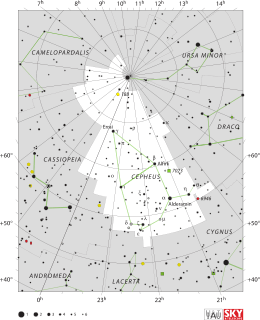HD 204521
HD 204521 is a star in the northern constellation of Cepheus. In the sky it positioned just to the west of the magnitude 3.2 star Beta Cephei (β Cep). This object has a yellow hue similar to the Sun but is too faint to be visible to the naked eye with an apparent visual magnitude of 7.26.[2] It is located at a distance of 86 light years from the Sun based on parallax, and has an absolute magnitude of 5.15.[2] The star is drifting closer with a radial velocity of −77 km/s,[2] and is predicted to come to within 7.96 light-years in 334,000 years.[5] At that distance the star can have a relatively small perturbing effect on comets in the Oort cloud.[8]
| Observation data Epoch J2000 Equinox J2000 | |
|---|---|
| Constellation | Cepheus |
| Right ascension | 21h 25m 16.79707s[1] |
| Declination | +70° 28′ 39.1412″[1] |
| Apparent magnitude (V) | 7.26[2] (binoculars) |
| Characteristics | |
| Spectral type | G0V[3] |
| B−V color index | 0.619±0.015[2] |
| Astrometry | |
| Radial velocity (Rv) | −76.6±0.3[2] km/s |
| Proper motion (μ) | RA: +40.601[1] mas/yr Dec.: +39.564[1] mas/yr |
| Parallax (π) | 37.9131 ± 0.0279[1] mas |
| Distance | 86.03 ± 0.06 ly (26.38 ± 0.02 pc) |
| Absolute magnitude (MV) | 5.15[2] |
| Details | |
| Mass | 0.77±0.03[4] or 0.997[5] M☉ |
| Luminosity | 0.86[2] L☉ |
| Surface gravity (log g) | 4.43±0.02[4] cgs |
| Temperature | 5,699±50[4] K |
| Metallicity [Fe/H] | −0.75±0.05[4] dex |
| Age | 8.43±4.24[6] Gyr |
| Other designations | |
| Database references | |
| SIMBAD | data |
This is an ordinary G-type main-sequence star with a stellar classification of G0V,[3] indicating that it is generating energy through core hydrogen fusion. It is roughly 8[6] billion years old and appears metal-deficient.[9] The mass of this star appears to be at or below that of the Sun, and it is radiating 86%[2] of the Sun's luminosity from its photosphere at an effective temperature of 5,699 K.[4]
References
- Brown, A. G. A.; et al. (Gaia collaboration) (August 2018). "Gaia Data Release 2: Summary of the contents and survey properties". Astronomy & Astrophysics. 616. A1. arXiv:1804.09365. Bibcode:2018A&A...616A...1G. doi:10.1051/0004-6361/201833051. Gaia DR2 record for this source at VizieR.
- Anderson, E.; Francis, Ch. (2012). "XHIP: An extended hipparcos compilation". Astronomy Letters. 38 (5): 331. arXiv:1108.4971. Bibcode:2012AstL...38..331A. doi:10.1134/S1063773712050015.
- Gray, R. O.; et al. (2003). "Contributions to the Nearby Stars (NStars) Project: Spectroscopy of Stars Earlier than M0 within 40 Parsecs: The Northern Sample. I". The Astronomical Journal. 126 (4): 2048. arXiv:astro-ph/0308182. Bibcode:2003AJ....126.2048G. doi:10.1086/378365.
- Aguilera-Gómez, Claudia; et al. (2018). "Lithium abundance patterns of late-F stars: An in-depth analysis of the lithium desert". Astronomy and Astrophysics. 614: A55. arXiv:1803.05922. Bibcode:2018A&A...614A..55A. doi:10.1051/0004-6361/201732209.
- Bailer-Jones, C.A.L.; et al. (2018). "New stellar encounters discovered in the second Gaia data release". Astronomy & Astrophysics. 616: A37. arXiv:1805.07581. Bibcode:2018A&A...616A..37B. doi:10.1051/0004-6361/201833456.
- Pace, G. (March 2013). "Chromospheric activity as age indicator. An L-shaped chromospheric-activity versus age diagram". Astronomy & Astrophysics. 551: 4. arXiv:1301.5651. Bibcode:2013A&A...551L...8P. doi:10.1051/0004-6361/201220364. L8.
- "HD 204521". SIMBAD. Centre de données astronomiques de Strasbourg. Retrieved 2020-03-07.
- Torres, S.; et al. (September 2019). "Galactic tide and local stellar perturbations on the Oort cloud: creation of interstellar comets". Astronomy & Astrophysics. 629: 13. arXiv:1906.10617. Bibcode:2019A&A...629A.139T. doi:10.1051/0004-6361/201935330. A139.
- Bond, Howard E. (September 1970). "A Search for Metal-Deficient Stars". Astrophysical Journal Supplement. 22: 117. Bibcode:1970ApJS...22..117B. doi:10.1086/190220.
External links
- Wikisky image of HD 204521 (HIP 105766)
- List of G stars within 100 light-years
